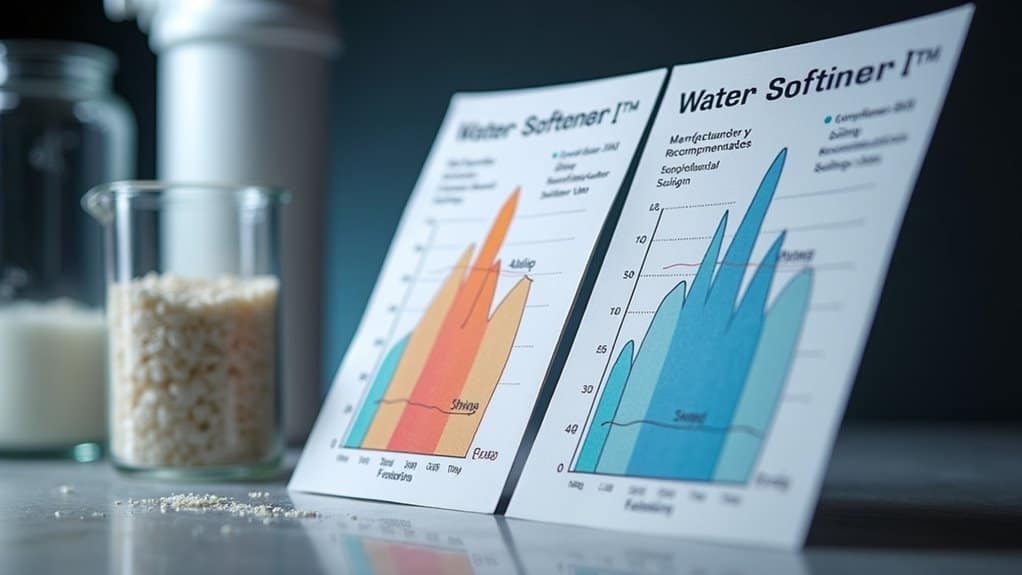Traditional water softener grain charts mislead homeowners by relying on generic consumption estimates while ignoring crucial variables. We’ve found they fail to account for peak demand scenarios, comprehensive water chemistry, and household-specific usage patterns. These oversimplifications often lead to improperly sized systems that either waste resources or experience premature breakthrough. Proper sizing requires balancing capacity with flow rates, considering all hardness-causing minerals, and optimizing regeneration cycles—factors the industry’s one-size-fits-all approach conveniently overlooks.
Key Takeaways
- Grain charts fail to factor in peak demand scenarios like morning rush hours when multiple water sources are used simultaneously.
- Standard sizing formulas don’t account for household-specific variables like older high-flow fixtures or outdoor irrigation needs.
- Larger systems aren’t always better and can cause resin bed stagnation, bacterial growth, and inefficient regeneration cycles.
- Traditional charts only measure calcium and magnesium, ignoring other minerals that affect system performance.
- Proper sizing balances grain capacity with actual household demand patterns to prevent salt and water waste.
The Household Water Reality Check: Beyond Generic Averages
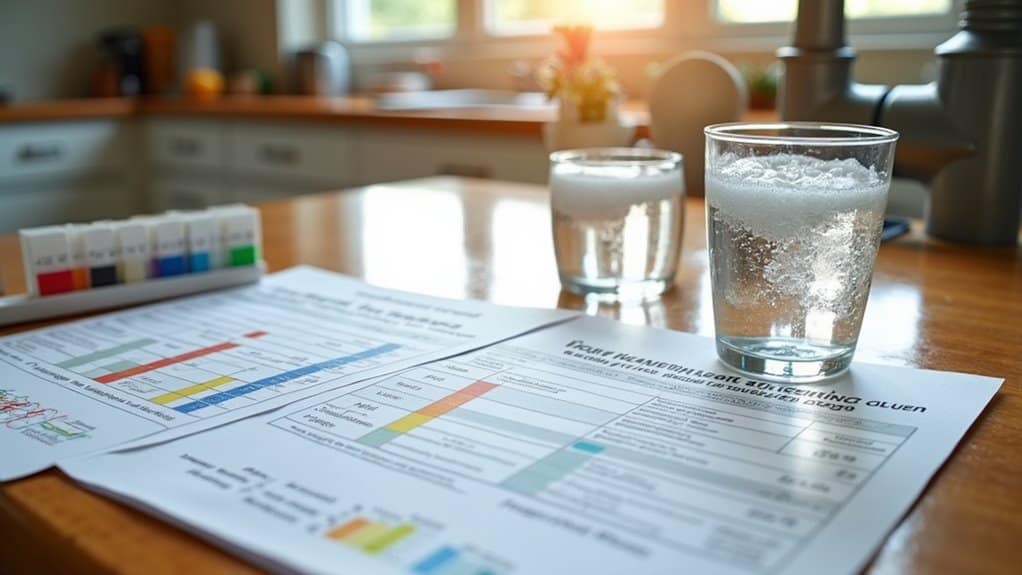
When consulting traditional water softener grain charts, most homeowners encounter a troubling disconnect between theoretical estimates and their actual usage patterns.
We’ve found standard calculations (typically 3,000 gallons/person/month) routinely fail to account for significant variables. Household size significantly impacts water consumption, making it essential to consider when sizing your softener.
Older homes with high-flow fixtures can use triple the water of modern ones, while outdoor irrigation can represent 30% of total usage—with half wasted through inefficiencies. A typical American household uses 138 gallons of water daily, making accurate softener sizing crucial.
Large families with teenagers or homes with water-dependent hobbies further skew predictions. These discrepancies aren’t minor—they’re system-breaking miscalculations that lead to premature exhaustion, inefficient regeneration cycles, and ultimately, inadequate water treatment.
Peak Demand Scenarios That Standard Charts Ignore
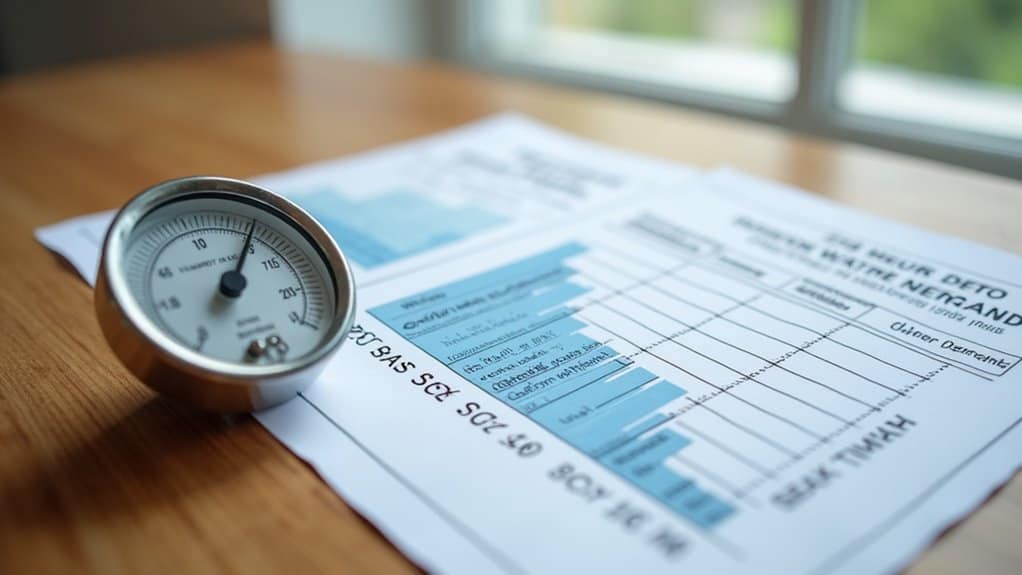
While traditional grain charts promise accurate sizing, they critically fail to address peak demand scenarios that determine real-world softener performance. Most sizing calculations ignore flow limitations that cause system failure during simultaneous appliance use. Understanding water softener performance requires Active Recall techniques that help homeowners better retain critical information about their systems. Additionally, optimal performance is achieved through careful consideration of both grain capacity and tank dimensions.
| Scenario | Impact on Standard Softener |
|---|---|
| Morning Rush | 12+ GPM demand exceeds 9″ tank capacity |
| Laundry + Showers | Resin bed compression, channeling |
| Multiple Bathrooms | Hard water breakthrough during peak use |
| Well Pump Cycling | Pressure drops, incomplete regeneration |
The reality? Tank diameter, not just grain capacity, determines performance. A properly sized 12″ tank handles 12 GPM, while common 9″ tanks max at 6.5 GPM—insufficient for multi-bathroom homes. Twin-alternating systems overcome these limitations by maintaining capacity during regeneration cycles.
Hardness Testing: The Missing Variables in Your Calculations
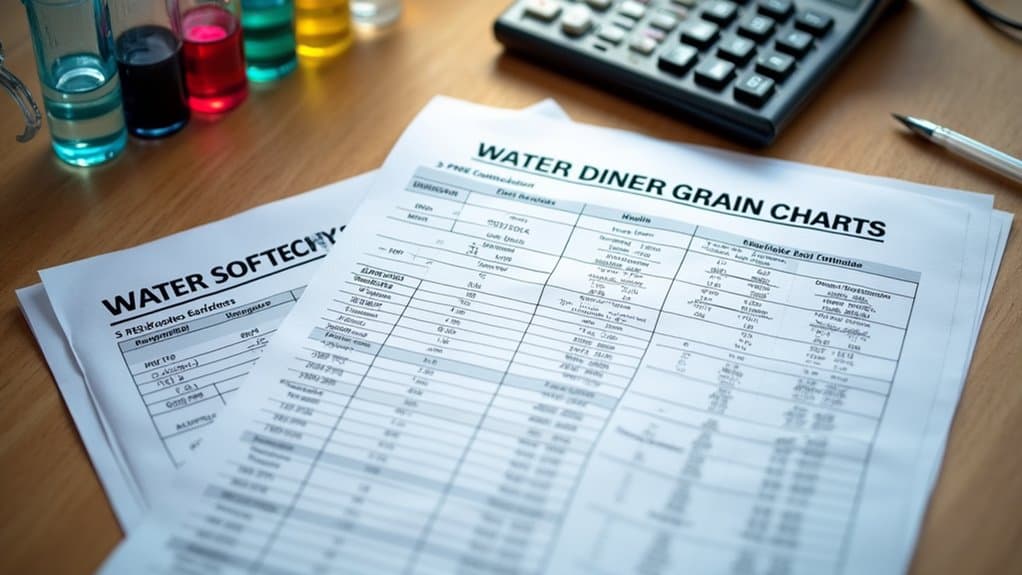
Standard water hardness testing methods fail to account for crucial variables that significantly impact softener performance. Most tests measure only calcium and magnesium while ignoring other cations like sodium and potassium that affect total conductivity. Additionally, water quality can fluctuate dramatically based on local geology, which is often overlooked in standard testing.
Testing limitations include pH dependency affecting EDTA reactions, temperature variations altering mineral solubility, and seasonal groundwater fluctuations rendering single-point measurements unreliable. The titration method, while considered reliable in laboratory settings, requires careful handling of buffer solution components to achieve accurate results.
Furthermore, the calcium-to-magnesium ratio—critical for predicting scale formation—remains unquantified in typical analyses, making it difficult to assess the true risk of scaling. Electronic testers require frequent recalibration, while visual titration endpoints may conflict with electrode measurements.
Even the widespread grains-per-gallon system oversimplifies by assuming uniform weighting of hardness contributors, which can lead to misleading conclusions about water treatment needs.
System Efficiency Ratios: Why Bigger Isn’t Always Better
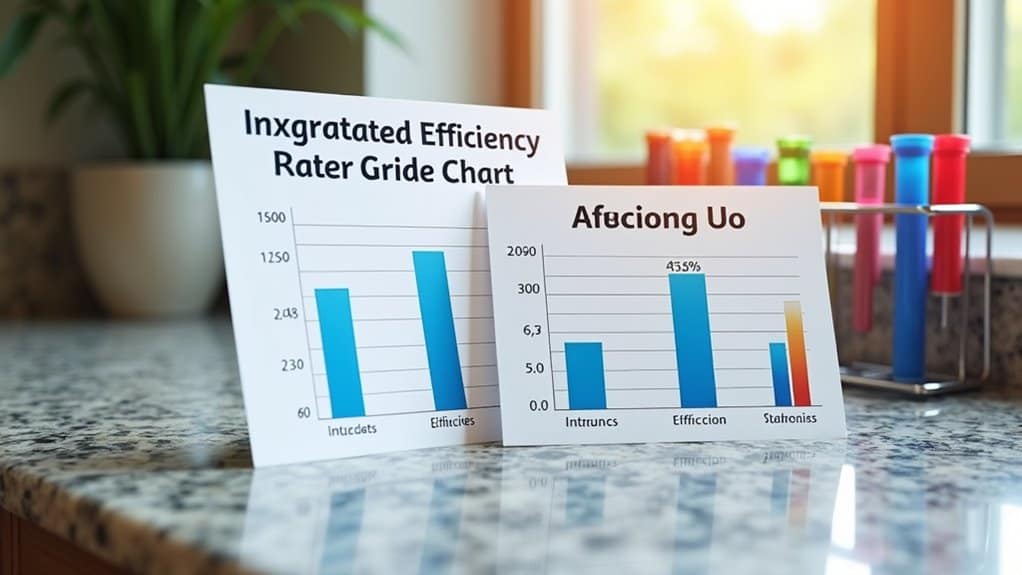
Despite the conventional wisdom that larger water softener systems deliver better performance, our research reveals a more nuanced reality driven by efficiency metrics rather than raw capacity.
Oversized systems often create operational problems that diminish their effectiveness.
Modern efficiency measurements prioritize:
- Grains per pound of salt (with high-efficiency units exceeding 4,000)
- Demand-initiated regeneration versus wasteful timer-based systems
- Proportional brining that regenerates only exhausted resin
Oversized units suffer from resin bed stagnation, bacterial growth, and premature resin degradation due to infrequent regeneration cycles. A properly sized water softener should balance grain capacity with household water demand to prevent these issues. Additionally, excessive water usage in oversized systems can lead to higher operational costs and inefficiencies.
These systems also waste salt and water while potentially exceeding design flow rates, compromising both capacity and performance.
Frequently Asked Questions
How Does Water Pressure Affect Softener Performance and Sizing?
We need adequate water pressure for proper softener operation. Insufficient pressure causes poor resin regeneration, while undersized units create pressure drops during peak usage, affecting overall system performance.
Can I Downsize My Softener if I Install Water-Efficient Appliances?
We can downsize your softener after installing efficient appliances, but we’ll need to recalculate daily grain removal while ensuring adequate flow rates during peak usage periods still meet your needs.
Do Vacation Homes Need Different Sizing Considerations?
We’ll need to oversize vacation home softeners to handle peak rental periods with 2-3× normal usage. Twin-tank systems prevent flow restrictions when multiple bathrooms operate simultaneously during high occupancy.
How Do Minerals Besides Calcium and Magnesium Impact Softener Sizing?
Iron and manganese dramatically impact sizing – they’re often overlooked. We’ve found iron adds 4-5 grains per 1ppm, while manganese requires 30-50% larger systems when combined with iron.
Should Well Water Systems Be Sized Differently Than Municipal Supplies?
Yes, we’ll size well water systems larger than municipal ones to accommodate mineral fluctuations, higher iron content, and varying contaminant loads that demand more frequent regeneration cycles and additional treatment capacity.
Conclusion
We’ve demonstrated that standard grain capacity charts represent merely a starting point for proper water softener sizing. True system optimization requires analyzing your household’s specific peak demand patterns, conducting comprehensive water testing beyond simple hardness levels, and calculating efficiency ratios that balance capacity with salt consumption. By incorporating these overlooked variables, we’ll help you select a system that delivers optimal performance while avoiding the unnecessary costs of oversized equipment.

Craig “The Water Guy” Phillips is the founder of Quality Water Treatment (QWT) and creator of SoftPro Water Systems.
With over 30 years of experience, Craig has transformed the water treatment industry through his commitment to honest solutions, innovative technology, and customer education.
Known for rejecting high-pressure sales tactics in favor of a consultative approach, Craig leads a family-owned business that serves thousands of households nationwide.
Craig continues to drive innovation in water treatment while maintaining his mission of “transforming water for the betterment of humanity” through transparent pricing, comprehensive customer support, and genuine expertise.
When not developing new water treatment solutions, Craig creates educational content to help homeowners make informed decisions about their water quality.


